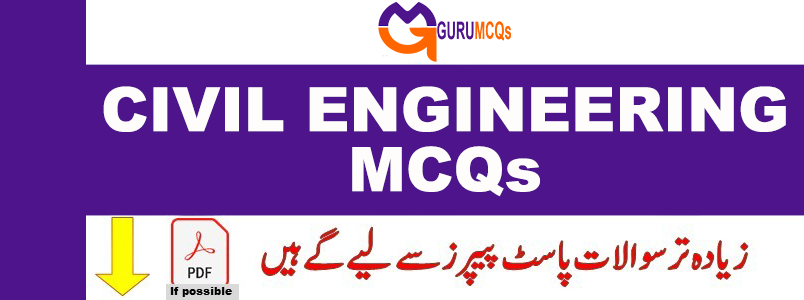
GURU MCQs provides Civil Engineering MCQs for Job Test and Interview Preparation, suitable for fresh graduates, students, and competitive exams. Most repeated civil engineering MCQs section is frequently encountered in CSS, PMS, Inspector, ASI, Sub-Inspector, Constable, FPSC, PPSC, ETEA, FIA, Police, Army, Navy, Airforce, IB, MOFA, ASF, LHC, Educators, and various other competitive exams, as well as government and private job assessments. The most common updated MCQs include Basic Civil Engineering, Building Materials, Surveying, Soil Mechanics and Foundation Engineering, Applied Mechanics, Hydraulics, Waste Water Engineering, RCC Structures Design, Irrigation, Railways, Construction Management, Theory of Structures, Estimating and Costing, Docks and Harbours, Elements of Remote Sensing, Building Construction, Concrete Technology, Advanced Surveying, Strength of Materials, Water Resources Engineering, Water Supply Engineering, Steel Structure Design, Highway Engineering, Airport Engineering, Structural Design Specifications, Tunnelling, and much more.
21. With increase in speed of the traffic stream, the maximum capacity of the lane________________?
A. increases
B. decreases
C. first increases and then decreases after reaching a maximum value at optimum speed
D. first decreases and then increases after reaching a minimum value at optimum speed
22. If the stopping distance and average length of a vehicle are 18 m and 6 m respectively, then the theoretical maxi¬mum capacity of a traffic lane at a speed of 10 m/sec is________________?
A. 1500 vehicles per hour
B. 2000 vehicles per hour
C. 2500 vehicles per hour
D. 3000 vehicles per hour
23. The diagram which shows all important physical conditions of an accident location like roadway limits, bridges, trees and all details of roadway conditions is known as_____________?
A. pie chart
B. spot maps
C. condition diagram
D. collision diagram
24. The background colour of the informatory sign board is______________?
A. red
B. yellow
C. green
D. white
25. When the speed of traffic flow becomes zero,then_______________?
A. traffic density attains maximum value whereas traffic volume becomes zero
B. traffic density and traffic volume both attain maximum value
C. traffic density and traffic volume both become zero
D. traffic density becomes zero whereas traffic volume attains maximum value
26. Scientific planning of transportation system and mass transit facilities in cities should be based on_____________?
A. spot speed data
B. origin and destination data
C. traffic volume data
D. accident data
27. On a right angled road intersection with two way traffic, the total number of conflict points is______________?
A. 6
B. 11
C. 18
D. 24
28. Which of the following is indicated by a warning sign ?
A. level crossing
B. no parking
C. end of speed limit
D. overtaking prohibited
29. The most efficient traffic signal system is________________?
A. simultaneous system
B. alternate system
C. flexible progressive system
D. simple progressive system
30. Select the incorrect statement?
A. Stop or red time of a signal is the sum of go and clearance intervals for the cross flow
B. Go or green time of a signal is the sum of stop and clearance intervals for the cross flow
C. Clearance time is generally 3 to 5 seconds
D. The cycle length is normally 40 to 60 seconds for two phase signals

Pingback: Software Engineering MCQs for Preparation - GURU MCQS